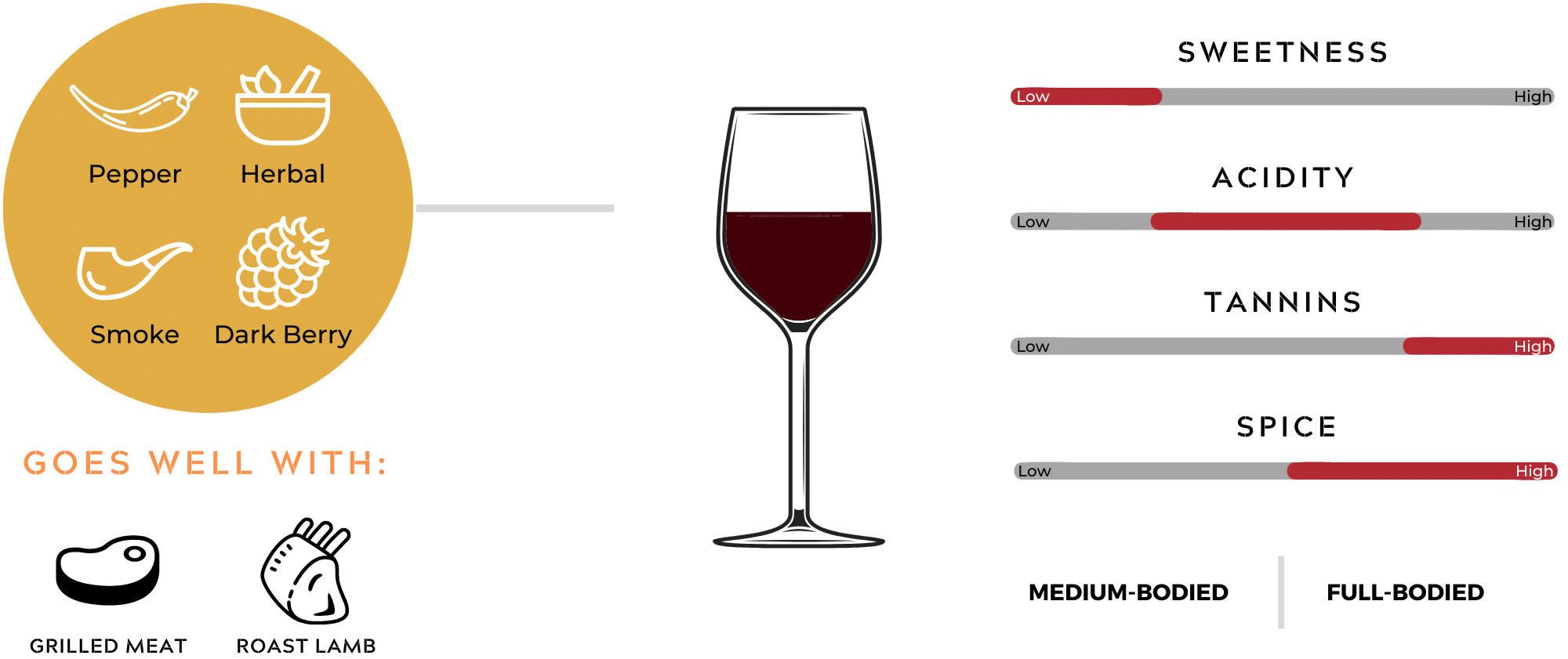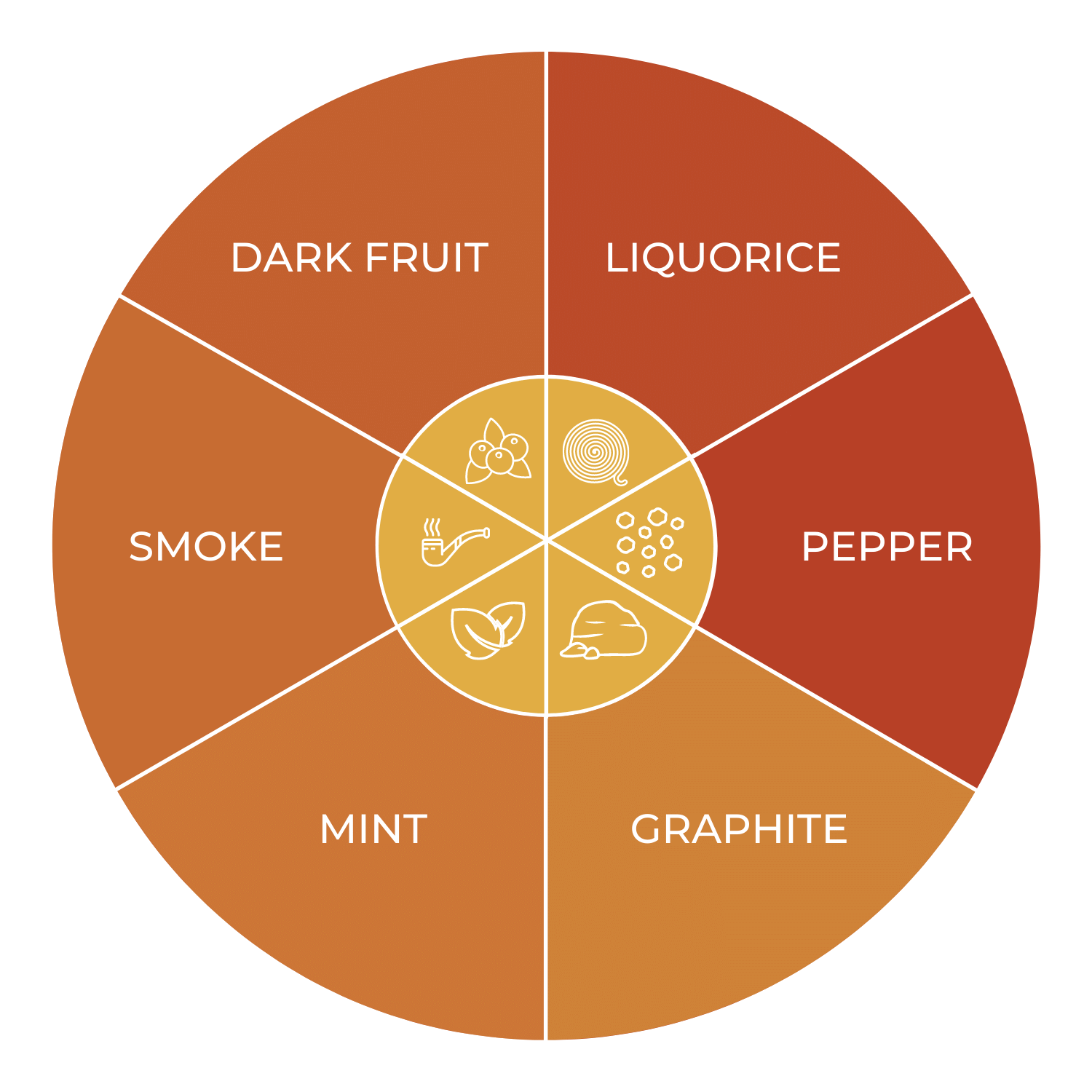Cabernet sauvignon wines are much prized for their complex flavour profile and full-bodied nature that makes them a wonderful accompaniment to a variety of heavily-flavoured meat dishes.
In this guide to cabernet sauvignon, we explore more about this style of red wine and provide you with all of that you need to know to begin your tasting journey.
To get a quick idea of how these wines will taste, and how they match with food, see our handy graphic below.
This grape varietal is so named due to the fact that it is actually the combination of two other grape varietals together, the cabernet franc and sauvignon blanc grapes.
Though the exact origins of how this union came to be is not exactly clear it is understood to have occurred at some point during the 17th or 18th Centuries in France, where it quickly rose in popularity amongst winemakers in the Bordeaux winemaking region, where it is native to.
The reason behind the grapes fondness amongst winemakers stems from the fact that it has an excellent ability to grow in a variety of very diverse geographical conditions, making it able to be effectively cultivated in a myriad of regions and countries.
The exact flavour profile of cabernet sauvignon wines can vary greatly depending upon a number of factors, most of which have to do with the growing conditions of the grape itself.
That being said, most examples of these wines will present as medium to full bodied in their nature, with moderate amounts of acidity partnered with a substantial tannin structure, meaning that they are some of the most age worthy wines available.
Some of the specific flavours found include dark berries and fruits, earthy notes of soil and ash, and even dry spice and sometimes herbs.
Similar to other grape varietals, cabernet sauvignon wines will taste slightly different depending upon the climatic and geographical conditions in which the grapes used were grown.
Those heralding from cooler climate regions will have a tendency towards being less ripe and intense in their overall fruit flavours, with a focus instead being made on the spice and acidity levels.
When coming from warmer regions, however, cabernet sauvignon wines will often have more intense ripe fruit flavours and levels of alcohol but lower acidity. Depending on your taste preference, it always pays to consider the origins of the wine when looking to buy.
As mentioned previously, cabernet sauvignons roots lie in the Bordeaux region of France, which is in the south west of that country.
Though it is grown throughout many other parts of the country as well, Bordeaux winemakers famously use the grape in the incredibly prestigious Bordeaux Blend, which is the hallmark wine of the region.
Without going too much into the exact details of that region, the best Bordeaux cabernet sauvignons tend to come from the left bank of the river Gironde that runs through the area, where the soil is known to be quite gravelly, allowing for the effective retention of heat even in what is an overwhelmingly cooler climate.
Due to the geographical conditions of the Bordeaux region, the cabernet sauvignon wines produced there tend to be known for their drier, or less ripe and sweet, flavour profile that brings out herbal flavours, such as mint, alongside minerally notes of gravel and earth in addition to the more traditional dark berry and fruit.
To discover more about the cabernet sauvignon wines from the Bordeaux region, be sure to consider this article that explores the region in more depth.
Outside of France, it is well established that Australia produces some of the best examples of cabernet sauvignon wine available.
The grapes' history in the country began in the early 19th Century where it had a rough start due to the inexperience of the early winemakers, who consistently used it in blends rather than as a standalone varietal.
As a general guide, the two winemaking regions of the Coonawarra in South Australia and the Margaret River in Western Australia produce the best examples of cabernet sauvignon, though the wine is grown exceptionally well in other areas too.
Today, winemakers from the Coonawarra region in South Australia produce some truly exceptional examples of cabernet sauvignon wine, thanks, in large part, to the geographical conditions of the region.
The area is famous for possessing a unique red soil with limestone base that, when combined with the area's typically warm climate, allows for the grapes planted there to reach peak ripeness.
Flavourwise, the region produces cabernet sauvignon wines that are distinctly full-bodied and full-flavoured in their nature, with ripe berry and fruit flavours contrasted against more complex notes of mint, eucalyptus, and subtle spice.
Some of the best bottles of Coonawarra cabernet sauvignon are available for purchase from this site, for those who wish to begin their tasting journey here.
Although the Coonawarra region in Victoria has been producing wine for far longer than the Margaret River region in Western Australia, many examples of Margaret River cabernet sauvignon have ranked amongst the best wines produced from any region in Australia.
The success of the region lies in its geographical conditions, which are famously cooler and more moderate in comparison to the much warmer Coonawarra, resulting in wines that are slightly more complex in nature and closer to the original Bordeaux style.
Some of the common flavours found in Margaret River cabernet sauvignon wines include ripe spicy berry notes alongside slightly higher levels of acidity, with pepper and spice also taking a definitive stance.
This site offers many examples of Margaret River cabernet sauvignon available for purchase for those seeking to start their tasting journey in Western Australia winemaking.
Cabernet sauvignon wines, irrespective of the particular region from which they originate, are all exceptionally well matched alongside servings of heavy red meat or any other dish that is characteristically high in fat.
That being said, cooler climate cabernet sauvignon will pair best with portions of juicy steak or lamb, as the minty and spicy flavours present in these wines complements these dishes well.
Warmer climate cabernet sauvignons, however, will go best with rich burgers or braised beef ribs as the typically more ripe flavours present in these wines pair sublimely with these types of dishes.
There's a bottle of cabernet sauvignon out there for everyone. Here are some of the brands and bottles that we recommend you look out for the next time you're browsing online or in-store.
Ever wondered whether or not the age of a bottle of wine matters when deciding its quality? In this article, we explore just how important age is when looking at wine.
With bottle shops expanding their range, we’ve taken the time to explain why some wines are and some are not vegan & organic in order to help you choose wisely.
Ready to begin your journey into the world of wine but don’t know where to start? Here’s our primer on what bottles & styles to try when just starting out.





